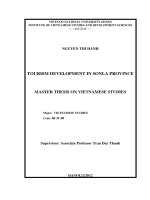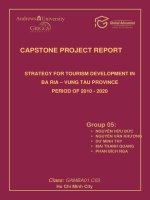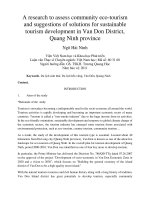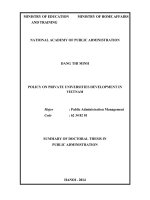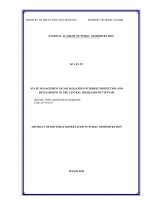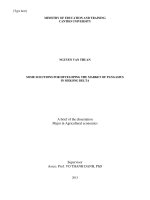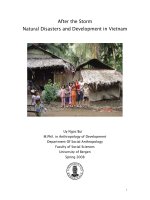AGRO PROCESSING INDUSTRY DEVELOPMENT IN KONTUM PROVINCE
Bạn đang xem bản rút gọn của tài liệu. Xem và tải ngay bản đầy đủ của tài liệu tại đây (155.67 KB, 27 trang )
MINISTRY OF EDUCATION AND TRAINING
THE UNIVERSITY OF DANANG
TRINH TRUNG KIEN
AGRO-PROCESSING INDUSTRY DEVELOPMENT
IN KONTUM PROVINCE
Major
Code
:
:
Industrial Economy
62.31.09.01
SUMMARY OF ECONOMIC DOCTORAL THESIS
DANANG - YEAR 2016
BE COMPLETED
AT THE UNIVERSITY OF DANANG
The scientific instructors:
1. Prof. Le The Gioi, PhD
2. Asso. Prof. Nguyen Hoa Nhan, PhD
Reviewer 1: Prof. Nguyen Ke Tuan, PhD
National Economics University
Reviewer 2: Prof. Nguyen Truong Son, PhD
Danang University of Economics
Reviewer 3: Nguyen Van Hung, PhD
Danang Institute for Socio–Economic Development
The thesis has been protected from the Review Board of
doctoral thesis evaluation at the University of Da Nang meeting
on May 14, 2016.
The thesis could be found in:
- National Library of Vietnam
- Learning & Information center - University of Danang
- Library of Economics University - University of Danang
1
INTRODUCTION
1. Urgency of research
For economic development in the Central Highlands region in recent
years, the Party and the State have focused set of guidelines and policies to
promote industrial development and processing A.P. in the Central Highlands.
However, Development of Agricultural Product Processing Industry
of Kon Tum still weak, not exploit, promote full comparative advantage.
To help clarify the theoretical basis and practical to set out the
guidelines and policies for D. of I.P. of A.P. Kon Tum sustainability
requirements in the period of accelerated industrialization, the current
modernization and international integration, the authors chose the theme:
"Development of agro-processing industries in the province of Kon Tum".
2. Research questions
3. Objectives of the study
- Develop a rationale for the D. of APPI locally
- Identify the basic content, design and analysis framework
developed criteria for evaluating APPI in strategic E. and social D.
- At the same time, orientation and proposed solutions mainly.
4. Objects and scope of the thesis research
4.1. Audience of research thesis: Development of APPI
Development in association with the economic development of the
province of Kon Tum
4.2. The scope of the thesis: Kon Tum province, from 2005 to 2015.
5. Research Methodology
The thesis uses the method of dialectical materialism, historical
materialism and integrated approach to do basic research methods. In
addition, the thesis uses the approach and system analysis, synthesis,
statistics, comparison, induction, ...
- Qualitative research: Refresh rationale, offering new concepts, new
models of industrial development in the processing of local agricultural products.
- Qualitative Research: To describe trends D. of APPI Kon Tum
according to the theoretical model, the thesis analyzes the E. statistics.
- Methods of synthesis (application integration theory in the study):
Theoretical background is built on the basis of multi-professional
2
integration, integrated interdisciplinary and cross-professional integration.
6. Overview of researches related to thesis
6.1. The domestic research
6.2.The theoretical study of international research to industrial
development associated with local economic development
6.3. These existing problems and missings to perform research D. of
APPI in Developing associated with local economic D. in the period of
accelerated industrialization, modernization and international integration
7. The new contributions of the thesis
About reasoning:
- The thesis has developed a theoretical basis for D. of APPI
Development in association with the local E. development in the period of
accelerated industrialization, modernization and international integration.
- Combined, creatively apply new theories. Develop a conceptual
framework, theoretical framework encompasses new ideas and analytical
frameworks developed agricultural processing industry.
- Applying the development of new perspectives on competitive strategy.
About reality:
- Applying the theory and problems associated with the actual
conditions of Kon Tum to analyze a comprehensive, in-depth processing
industry Agriculture
- Proposal perspective, development-oriented agricultural products
processing industry to Kon Tum province in the period of accelerated
industrialization, modernization and international integration.
- Proposal 7 solutions developed agricultural processing industry
8. General structure of the thesis
Besides the introduction, conclusion, list of references and
appendices, structural thesis into three chapters:
Chapter1: Rationale for Developing Agricultural products processing
industry locally.
Chapter 2: Status of Development of Agricultural Product Processing
Industry in Kon Tum.
Chapter 3: Orientation and solutions primarily to develop agricultural
products processing industry in the province of Kon Tum.
3
CHAPTER 1
RATIONALE FOR DEVELOPMENT
AGRICULTURAL PROCESSING INDUSTRY IN LOCAL
1.1. THEORETICAL FRAMEWORK OF INDUSTRIAL AND
PROCESSING INDUSTRIAL DEVELOPMENT AGRICULTURE
1.1.1. Conceptual Framework of Industry and Development of
Agricultural Product Processing Industry
Economics is a specialized Industrial Economics (Applied
Economics); Industrial Economics Research industry organizations,
industry structure and competitiveness.
Industry is the industry in the fields of material production - an
integral part of the physical production of society [50].
FAO Conference on Strategic Development of the food processing
industry and agricultural products, said that the strategy presented in
document C 7521 for development of food processing industry and
agriculture products is consistent with the objectives of an international
economic order and the new.
Agricultural products processing industry is the industry create Value
Manufacturing Industry on the basis of implementing the activities set of
inputs, and on preliminary organizational activities Processing Industry.
1.1.2. New perspectives on the Development of Agricultural
Product Processing Industry
1.1.3. Theoretical framework for Development of Agricultural
Product Processing Industry
Based on the theoretical framework of economic development, the
scholars make the process of economic development include the mismatch
between policy and development stages: Economy based on inputs
based
Economy
investment in Economy based on innovation. To develop
agricultural products processing industry in industrial development associated
with local economic development must go through three stages on.
To develop industrial processing of local agricultural products in the
period of accelerated industrialization, modernization and international
integration, with the goal of achieving growth and prosperity Sustainable
4
Development of Processing Industry Agriculture, the authors propose a
theoretical framework (Table 1.1. Conceptual framework of the
Development of Agricultural Product processing Industry in the locality).
Theoretical framework will be integrated to the authors develop the
basic content of the Development of APP Industry Development in
association with the local economic development in the period of accelerated
industrialization and modernization cultural and international integration.
1.2. CHARACTERISTICS, CLASSIFY AND ROLE OF APPI
1.2.1.Characteristics of agricultural products processing industry
- The industry that the material is largely seasonal.
- The industry has diversified products, abundant meet market demand.
- The industry is more likely to take advantage of raw materials to
improve the efficiency of production and business.
- The industry has a long tradition, especially Vietnam.
- APPI in accordance with the organization of small and medium
scale.
1.2.2. Classification of agricultural products processing industry
According to the traditional classification of the classification criteria
of the United Nations Industrial of all economic activities (ISIC), (1)
Production of Food, beverages and tobacco; (2) textile, apparel and leather
industry; (3) Manufacture of wood and wood products, including furniture;
(4) Manufacture of paper and paper products, printing and publishing; (5)
Manufacture of rubber products.
1.2.3. The role of agricultural products processing industry
- Have direct implications for the implementation of the restructuring
of industry.
- Contribute to the relationship between industry and agriculture, one
of the most fundamental relationship of the national economy.
- Contributing to the strategic importance of exports of many
countries in the process of industrialization and modernization.
- Contributing to satisfy the diverse needs and richness of people's lives.
5
1.3. CONTENT OF AGRICULTURAL PRODUCT PROCESSING
INDUSTRY DEVELOPMENT IN THE DEVELOPMENT OF LOCAL
INDUSTRY
1.3.1. The models of agricultural product processing industry
development locally
1.3.1.1. Model of Agricultural Product Processing Industry
Development integrated with production processes and closed
commercial activities: the production process industry involved in all
segments of the value chain that includes the production manufacturing and
processing industry organizations and consumer products; and branding,
trademarks and registration rights protected geographical indications.
1.3.1.2. Model of Agricultural Product Processing Industry
Developmenta ssociated with the development of sustainable agriculture
Development of Agricultural Product Processing Industry intimate
relationship, associated with the development of sustainable agriculture.
Agricultural products are inputs of the processing industry, processing to
create value-added greatly to agricultural products, but the competitiveness
of agricultural products not only from processing that depends very much
in the process of agricultural production, pure origin of agriculture.
Sustainable development of agriculture will determine the scale industries
Agriculture, direct impact on the rate of D. of processing industry.
Programs developed by FAO for SARD include:
- Method of sustainable living.
- Improving the sustainability of production systems synthesis.
SARD associated with three problems: (1) stable community life; (2)
system integrated agricultural sustainability; (3) integrated management of
natural resources.
1.3.2. Basic contents of agricultural product processing industry
development in the development of local industries
1.3.2.1. Determining comparative advantages in agricultural
product processing industry development locally
1.3.2.2. Creating competitive advantages in agricultural product
processing industry development locally
6
1.3.2.3. The role of local authority in researching, planning and
implementing development policies for APP industry
1.4. FACTORS AFFECTING THE AGRICULTURAL PROCESSING
INDUSTRY DEVELOPMENT IN LOCAL
1.4.1. The input factors
The position of local input factors needed to compete in an industry
as conditions of natural resources, land, labor, capital and infrastructure.
The inputs usually include manpower, resources, knowledge
resources, capital and infrastructure. Percentage use of inputs from different
sectors are different, so the country can exploit competitive advantage
through the development strategy of the industry with low usage rates most
appropriate inputs.
1.4.2. The groups of factors belong to local market
The first is constituted for the market.
The second is the size and growth of demand.
1.4.3. The local supporting industries
The presence of related industries often leads to the formation of the
competitive industry.
The industry is concerned that the business sector can link to
cooperate addition the development of this industry depends on the
development of service industries such as transport, customs, security
insurance, medical ...
1.4.4. Sector strategies and characteristics of enterprise
competitiveness in the industry
There are three specific content of this group, including sectoral
strategies and organizational structure of local enterprises; The objective
factors; competitive domestic factors.
1.4.5. Factor changes
In many practical cases, the success of a local or a local industry
based on random factors. These factors may include random as the
invention of new technologies, earthquakes, volcanoes, ... random factors
affecting the different local is different.
7
1.4.6. The role of the state
The state can impact positively or negatively on the group
conditions. State as its macroeconomic management have a huge impact on
the development of the industry in general and APP industry in particular.
State is the manufacturer; As the largest consumer protection; As investors
and the state as well as borrowers and lenders greatest.
1.4.7. The role of local authority
Policy D. at the local industrial policy has included a direct impact
on the level of inter-sectoral policy has included the impact on the level of
the sector in the province. ID. Policy works locally to attract business from
other areas to local, retain existing business, while encouraging the creation
of new enterprises. The agent D. of the local industry including
management, the enterprise inside and outside of the public sector and
private sector, and non-profit organizations and business associations.
1.5. FRAME ANALYSIS AND EVALUATION CRITERIA SYSTEM
FOR
THE
AGRICULTURAL
PROCESSING
INDUSTRY
DEVELOPMENT LOCALLY
1.5.1. Analytical Framework of Agricultural Product Processing
Industry Development Locally
On the theoretical basis and the approach chosen, the authors
construct an analytical framework Industrial Development processing of
local agricultural products (see Figure 1.4). Development of industrial
processing of local agricultural products were analyzed on three
perspective, which is determined comparative advantages to develop
agricultural products processing industry, creating competitive advantage,
the role of local government research methods in planning and
implementing development policies Agricultural processing industry and
the harmonious combination of the three issues.
1.5.2. Evaluation criteria system to developement IP of local AP
1.5.2.1. Criteria for evaluating the development of agricultural
products processing industry on the basis of assessing the condition and
characteristics of the local including: natural conditions, geographical
location, environment Economy - Society.
8
1.5.2.2. Criteria for determining comparative advantages of
products in agricultural products processing industry
1.5.2.3. Indicators, benchmarks of industrial competitiveness
The contribution rate of "total factor productivity", the CobbDouglas: Y = A.Kα .Lβ
labor productivity
capital productivity
Investment in research and deployment
skills of the workforce
1.5.2.4. Evaluation criteria for industrial development policies at the
local
a. Review the context of the
Analyze and evaluate the characteristics on the basis of the
evaluation strategy proposed, review the specific goals and objectives and
the underlying policies proposed to achieve the main objective is the love
for the assessment of policy development at the local industry.
b. Review policies for industrial development in the locality under
three approaches perspective
The author draws on research model towards sustainable
development (see Figure 1.5. Model Development Policy Research in local
industry towards Sustainable Development)
Following review policy approach 3 perspective.
(1) Sense of 1: Assessment and forecast position
(2) Sense of 2: Assessment and prediction of internal resources
(3) Sense of 3: Review and Forecast agents
c. Seven basic criteria for evaluating the performance of industrial D.
policies at the local level: (1) The E.; (2) Performance (Efficiency); (3)
Effectiveness (Effectiveness); (4) Calculate the impact; (5) The feasibility;
(6) The appropriateness; (7) The uniformity in implementation.
1.6. EXPERIENCE IN AGRICULTURAL PROCESSING INDUSTRY
DEVELOPMENT OF OTHER COUNTRIES
1.6.1. The experience of the United States
1.6.1.1. Focus on developing AP have competitive advantages
9
1.6.1.2. Promote the application of scientific – technological
advances in producting and processing agricultural products
1.6.2. Experience of Malaysia
1.6.3. Experience of Singapore
1.6.4. Experience of Indonesia
1.6.5. Experience of Philippines
1.6.6. Experience of Thailand
1.6.7. Experience in producting and processing typical AP in
Vietnam
1.6.8. Lessons learned for Developing Agricultural PPI in local
CONCLUSION CHAPTER 1
CHAPTER 2
REALITY DEVELOPMENT INDUSTRY
IN AGRICULTURAL PROCESSING KONTUM
2.1. NATURAL CONDITIONS, THE ECONOMIC - SOCIAL
KONTUM
2.1.1. The natural conditions
2.1.2. Economic, social
2.2. REALITY OF INDUSTRIAL DEVELOPMENT IN KON TUM
PROVINCE
2.2.1. Potential for industrial development in KonTum province
2.2.1.1. Potentials, strengths and advantages for industrial
development
2.2.1.2. Assessment of exploiting, promoting potentials and
strengths for socio-economic development in KonTum recent times
2.2.2. The status of industrial development in KonTum
2.2.2.1. Number of industries, cottage industries according to
economic sector
By the end of 2014, the province of Kon Tum has 3,541 manufacturing
establishments Industry, Handicraft, non-state institutions accounted for over
99%, the central state enterprises have 4 establishments, enterprises local
government also has 3 facility. Number of establishments belonging to the
10
private capitalist economy has grown rapidly, with 11 establishments in 2000
to 2014 with 47 establishments. Areas where foreign investment is only 01
joint venture manufacturing facility starch in Sa Thay district.
2.2.2.2. Sort by subsector industry
By industry, the base processing industry accounts for over 90%,
base 2005 (2,302); (3,541) 2014 as base. Mining industry has a strong rise
in the number of production facilities in the period 2001-2005, from 11
sites in 2000 increased 54 basis in 2005 and 2014 is 73 basis. 2005 the
province has 01 production facilities and distribution of electricity, by 2014
the number of establishments engaged in manufacturing sector
Manufacturing & Distribution Utilities 28 basis.
2.2.3. Industrial workforce - handicraft
2.2.3.1. Evolution of labor distribution according to the economic
sectors and economic sectors
Due to the impact of the economic downturn should labor industry
decreased in 2014 with 10,914 employees Industry. In the mining industry
there are 734 people, 9,453 processing industry is the production and
distribution of water is 727 people.
2.2.3.2. Labor situation by level
Through the survey, not a high-quality labor, unskilled labor
accounts for over 80%, and work with professional secondary education
and vocational training for about 7%, workers with college degrees and
university or higher accounted for less than 10%, while the Kon Tum is 01
professional secondary schools, 02 colleges and 01 university campuses
can train thousands of workers each year.
2.2.4. The situation of industrial investment - handicraft
2.2.4.1. Movements of capital for industry - handicraft
2011 capital for industry increased by more than 8.48 times
compared to 2007, reaching 857.2 billion accounting for 14.67% of the
total investment capital of society. In 2012, investment in industry
continued reached 1055.6 billion increased 16.7% compared to the total
investment. However, in 2014 investment in industry decreased slightly to
1,042 billion, accounting for 13.65% of the total investment.
11
2.2.4.2. The total fixed assets value of the industry
2007 and 2008 due to manufacturing and distribution utilities are
investing heavily to the value of fixed assets of the sector accounts for over
50% of the total value of fixed assets industry, given the proportion of fixed
assets Industry sector compared to 32.46% whole society in 2007, 2008
was 27.3%, in 2010 was 29%, increased to 34.42% in 2011, 2012 and 2014
was 34.73 decreased slightly to 31.73%.
2.2.5. Results of industrial activity
2.2.5.1. The value of industrial production and growth rate by
sector
The period 2006-2014, the growth industry of the two districts have
reached the figure, the highest district, Dak 24.8% / year, Kon Plong
district reaches 20% / year; Kon Tum city and Sa Thay achieved
respectively 19.9% / year and 18.3% / year, the lowest growth Tu Mo Rong
district -2.1% / year.
2.2.5.2. Value added of industry
The proportion of value-added industry in the structure of the total
value-added whole society in current prices in 2000 was 8.11%, 8.26% in
2005, 2009 was 8.09% (as reported I. 10.5%), 2010 increased 10.22%,
9.27% in 2011 down to 2012 and increased to 10.89% in 2014 to maintain
10.73%. The contribution of value-added industry in GDP provinces
showed a slight downward trend in the last period, the ID is not really
sustainable.
2.2.5.3. Main products of handicraft industry
2006-2014 period, most of the products are mainly positive growth.
After the hydro power plants in operation gave an average growth phases of
electrical products reached 230.6% / year, plywood production growth rate
reached 44.7% / year and tapioca reached 38.3% / year. Some of the
negative growth is the product timber (closed forest policy by the province)
-18.9% / year and terracotta tiles -6.6% / year.
2.2.5.4. The export value of industry
Export turnover rise year over year. The period 2006-2014, the
province's exports growth rate averaged 34.46% / year. Major export
12
products: tapioca flour, textiles, furniture, coffee, rubber ...
2.2.5.5. The efficiency in manufacturing of the business
Overall in the last period, the efficiency of the PI is low, even a loss
of the year. Chiefly because markets are shrinking; competitiveness of the
industry, capacity utilization ratio low. Specific movements outlined in
Table 2:12. Gains and losses of the business industry.
2.2.6. Evaluate technological standard of the economic sectors
Machinery and equipment of most of the production facilities in the
province Industry outdated and worn almost worth using.
Most enterprises use coefficients design capacity of less than 80%.
2.2.7. Industrial restructuration
2.2.7.1. Restructured by regions
Industry in the province is concentrated mainly in the city of Kon
Tum, however in recent years there has been a significant shift.
In 2013, the proportion of Kon Tum city accounted for 77.98% increase,
district, Dak reduced to 11.52% and 4.95% Sa Thay district and Dak Ha
accounted for 1.96%. The lowest is 3 Kon Plong district, Tu Mo Rong and Dak
Glei respectively accounted for only 0.32%; 0.39% and 0.71%.
2.2.7.2. Restructured by industry sector
By 2014, overall industry structure was formed as follows: food P.
industry Beverage highest proportion of 34.38%, the wood processing
industry paper dropped to 14%, the other sectors do not fluctuate much.
However, the share of electricity production and distribution of water has
increased reaching 25.54% compared with 5.23% in 2005, the lowest is the
chemical industry: 2.76% and textiles - footwear is 2.26%.
2.2.8. Current status of development in industrial clusters at
KonTum
To make the land as the basis of ID in the next stage, Kon Tum is
planning further D. some clusters I. in the districts to attract investment I.,
promote the transfer of economic restructuring, labor structure.
2.2.9. General assessment of the current status of industry
2.2.9.1. The achievements and causes
2.2.9.2. The remainings and causes
13
2.3.
THE
SITUATION
OF
MAINS
AGRICULTURAL
PRODUCTION AND AGRICULTURAL PRODUCT PROCESSING
INDUSTRY DEVELOPMENT IN KONTUM
2.3.1. The situation of mains agricultural produce
2.3.1.1. Annual crop sector
Although in recent years, the industry's annual crop growing
provinces, plant structure shifted towards positive; area, yield and production
of some key crops (rice, maize, cassava, vegetables...) tends to increase,
contributing to ensure food demand, food demand Using people and meet
part of the demand for livestock sector D. and PIAP of the province. In 2014,
the PV of the sector reached 230 005 annual crop million, an increase of 69
999 million compared with 2000, the average period from 2000 to 2014 the
PV of annual crop sector increased 3.263/year. The proportion of annual
crops in the province's agriculture accounting for 18.340% in 2014.
However, the D. of annual crops unplanned, fragmented, low crop yields,
resistance to pests and low product quality.
2.3.1.2. Perennial crop sector
Kon Tum have soil conditions, soil and climate are suitable for
planting some perennials ... In recent years, perennial crop sector in the
province has grown rapidly, contributing to E. restructuring in A. and rural
D., resolving employment and raise incomes for workers. The production
value of perennial crop sector in the province increased from 169 250
million in 2000 to 816 936 million in 2014, the average period from 2000
to 2014 the PV of perennial crop sector increased by 11.63% / year. For
perennial crops in the province are mainly rubber, coffee is being D. for
various types: SFE rural E., household E., and gardens, E. Farm forming
specialized areas of I. crops of high economic value such as specialized
areas of coffee P. in Dak Ha district, rubber growing areas are concentrated
in the city of Kon Tum Sa Thay district, Dak Ha Ngoc Hoi...
2.3.1.3. Livestock sector
The production value increased from 85 075 livestock sector million
14
in 2000 to 212 029 million in 2014, the average period from 2000 to 2014
increased by 3.39% / year; although the value of the livestock sector P.
increased, but the proportion of the value of production of the livestock
sector in the total value of AP tends to decrease (down from 16.25% in
2000 to 9,06% in 2012).
2.3.1.4. Factors affecting mains agricultural production in KonTum
- Fluctuations in commodity prices internationally market continues to
take place in a difficult to control, especially for agricultural commodities are
considered strengths of the province affected by two main factors.
+ The situation of climate change and disease
+ Demand continues to increase, especially in emerging economics
and D. countries, the impact of TF to the majority of countries.
- P. of a large segment of the rural P. in the province is still under
traditional cultivation practices, P. also brings self-sufficient.
- Technology of P. enterprises in the province is still quite backward,
failing to meet the requirements of P. and business.
2.3.2. Situation of agricultural product processing industry
development in KonTum
Industry P. value of agricultural products processing industry of the
province is increasing, the average period 2005 - 2014 average increase of
31.67% / year, contributing substantially to the E. growth. The results of
analysis and evaluation through seven criteria.
2.3.2.1. Rubber Products
2.3.2.2. Coffee Products
2.3.2.3. Tapioca Products
2.4. ANALYSISING AND EVALUATING CONTENTS OF
AGRICULTURAL
PRODUCT
PROCESSING
INDUSTRY
DEVELOPMENT IN KONTUM PROVINCE
2.4.1. Identifying comparative advantages in developing
agricultural product processing industry to development economic of
KonTum province
2.4.1.1. Identify the advantages of KonTum
15
2.4.1.2. The role of the local authority in promoting comparative
advantages of agricultural product processing industry development
- Planning, identifying plants and animals suitable for each ecoregion
and market demand.
- The first step in cooperation with the ministries and central agencies
to invest in construction of infrastructure in industrial zones.
- To build parks and Industry to attract enterprises in the industrial area.
- Promote the implementation of innovation, acquisitions, and
improving the efficiency of state enterprises. Supporting BAI locally.
- ...
2.4.1.3. Assessing the situation of producting, processing and
exporting of main agricultural products (coffee, rubber) in KonTum
Province.
a. Assessing the situation of producting, processing and exporting
of coffee
* In terms of volume and export value of Vietnamese coffee:
Approximately 95% of coffee production in Vietnam is used for export.
* The cost of coffee production in Vietnam
Table 2:29. Comparision of prices of coffee production in Vietnam
with some competitors
Price
%
Number
Country
(Vietnam = 100%)
(USD/ton)
1
India
921
115
2
Indonesia
929
116
3
Vietnam
800
100
Source: Ministry of Agriculture and Rural Development.
Compared to some robusta coffee growing countries of Vietnam, the
producers have a competitive advantage over
Table 2:30. Domestic Resource Cost Coefficient (calculated for
Robusta coffee )
Country of Origin
Number
DRC
1
Vietnam
0,77
2
Indonesia
0,81
3
Braxin
0,83
Source: Calculations of the subject; World Production of Coffee, ICO
16
* The average export of coffee in Vietnam
- In the period 2002 - 2015: Coffee prices began to recover slowly,
going from 448 USD / tonne in 2002 to 2015 is 1896 USD / t, and
gradually approach the average prices of the world.
* Market Share and Market for Vietnam coffee exports
Coffee exports of Vietnam in 2008 accounted for 14.61% of 2nd
coffee export market in the world, behind Brazil (accounting for 34.48%);
The consumer market is constantly expanding, in 1996 exports to 34
countries, in 1999, exports to 40 countries. As of 2015, Vietnam's coffee
was available in 110 countries and territories.
b. Assessing the situation of rubber producting and exporting
* In terms of volume and value export of rubber
The growth rate of export volume and growth rate of export turnover
of Vietnam rubber relatively steadily, year after year. Accordingly, the total
volume of rubber exports in the period 2009 - 2015 reached 7.370 million
tons with a total turnover of about 17.500 million, accounting for 2.3% of
total exports of the country.
* In terms of the cost of rubber production
Latex yield and production cost of the Vietnam Rubber relatively low
compared to some competitors in the region.
Cost domestic source of rubber for export production of Kontum
period 2005 - 2015, the DRC = 1,017 and comparative advantage index
publicity basically RCA = 2.15 is not highly effective.
* In terms of rubber exporting price
Time of latex price is 2011, the average export price of 01 tons of
rubber is 3961 USD / t, the price of rubber dropped to the lowest was in
1999, with 01 tons of rubber is only 533 USD / ton. On average, prices
average export rubber in Vietnam are lower than the average prices of the
world and unstable. RSS3 same item but the price of Vietnam's rubber
inform markets are less than Malaysia and Singapore.
* In terms of market share and rubber exporting market of Vietnam
In the period 2010 - 2015, the share of export of rubber in Vietnam
despite increased compared to the period from 2004 - 2009, but only gained
17
about 7.6% of total exports of natural rubber in the world
2.4.2. Creating competitive advantages to promote agricultural
product processing industry development in KonTum province
2.4.2.1. Analysising and evaluating the competitive advantages for
development creation of agricultural product processing industry
development in KonTum province
The results of the questionnaire survey are shown from table to table
2:30-2:45. This indicates, these measures create a competitive advantage in
the Development of APPI in the province is still mainly based on
comparative advantage, or metabolic initial comparative advantage into
profit competitiveness of products. Group elements that make up an
important competitive advantage hardly adequate attention. Therefore,
creating a competitive advantage in the Development of Agricultural
Products Processing Industry of the province contains many restrictions.
2.4.2.2. Analysis of the evaluation criteria competitiveness of
agricultural products processing industry in KonTum
a. The contribution of TFP growth in the agricultural processing
industry
Last time, the growth of APPI continued to increase, with the average
rate on a 75% / year. We can see the contribution of TFP to value-added
processing of agricultural products over time (see Table 2:46).
b. Labor productivity of agro-processing industries Kon Tum
Province
Based on these statistics, the labor productivity of APPI over time are
shown in Table 2:47. Labor productivity of agricultural products processing
industry is growing with an average growth rate reached 15.83% / year.
Also during this period, the yield of A. products industry achieved 1.3
times higher than the average labor productivity of the economy.
c. Investment of agro-processing industries Kon Tum Province
From 2010 to 2014, investment in APPI of Kon Tum tend to rise an
average of 1.86 times / year, 100% invested in the country.
In short, can confirm that processing Kon Tum Agricultural products
are gradually asserted its position in the market.
18
2.4.3. Review the policies of agricultural product processing
industry development in KonTum province
2.4.3.1. Review policy by approaching perspective 3: Recognize the
development of industrial policy processing agricultural products under
three Kon Tum perspective: (1) Evaluate the position; (2) Evaluate the
endogenous factors; (3) Evaluate the agent.
2.4.3.2. Review Policy under 7 basic criteria: (1) The economics of
policy; (2) The effectiveness of the policy; (3) The validity of the policy;
(4) Calculate the impact of the policy; (5) The feasibility of the policy; (6)
The relevance of the policy; (7) Consistency in policy implementation.
2.4.3.3. Review the policy making process of agricultural products
processing industry development: policy-making process is very important
cycle from beginning to end stages to ensure the suitability and feasibility
of policies issued, include: Define policy issues; Define policy objectives; Identify policy options.
2.4.3.4. Review the implementing policies: policies for each group:
Group investment policy of industrial development; Policy support land
access; Trade policy, market; Science and Technology Policy; Policies to
improve the business environment; Policy development of human
resources; Policies for sustainable industrial development.
2.4.3.5. General assessment of the development policies to
agricultural products processing industry in KonTum
a. Achievements
b. Limitations
c. The cause of the limitations
2.4.4. Analysising and evaluating factors affecting the of
agricultural products processing industry development in KonTum
The results of analysis and evaluation was the author elaborates on
seven factors affecting the D of APPI in Kon Tum province in the past year
2.4.5. Raised issues of agricultural products processing industry
development in KonTum Province
- The province not give full play to comparative advantage in the
Development of Agricultural Product Processing Industry in the long term.
19
- Compared with the country, the type of product in the province
have low competitiveness.
- No investigation, adequate assessment of the advantages and
disadvantages in the Development of Agricultural P.P. Industry.
- Lack of planning and policy advantages in the D of APPI.
- Research and application of organizational development models
produced advanced processing of agricultural products is very limited.
CONCLUSION CHAPTER 2
CHAPTER 3
ORIENTATION AND DEVELOPMENT SOLUTIONS
AGRICULTURAL PROCESSING INDUSTRY IN KONTUM
3.1. INDUSTRIAL DEVELOPMENT PLAN IN KONTUM STAGE
2015 - 2020, ORIENTED TO 2025
3.1.1. Industrial development perspective
3.1.2. The goals of industrial development
3.1.3. The orientation of industrial development
3.1.4. The development plans
3.1.5. Justifying and choosing plan for developing industry
3.1.6. Planning and Development of APPI in Kon Tum
3.1.6.1. Development Orientation
3.1.6.2. Planning for processing industry Agriculture and Food
3.2. OPPORTUNITIES, CHALLENGES AND CHOOSING MODEL
FOR AGRICULTURAL PROCESSING INDUSTRY DEVELOPMENT
IN KONTUM PROVINCE
3.2.1. Opportunities and challenges for the development of APPI
in the Central Highlands in the international economic integration
3.2.1.1. Opportunity
3.2.1.2. Challenge
3.2.2. Choosing model for agricultural processing industry
development and way to organize in KonTum
3.3.
SOLUTION
FOR
AGRICULTURAL
PROCESSING
INDUSTRYDEVELOPMENT IN KONTUM PROVINCE
20
3.3.1. Integration solution for deployment models to new model
of strategic development
3.3.1.1. Applying research of intergrating Agricultural Products
Processing Industry Development model and closed production process
- Research and D. and product design in order to diversify products
- Preparation of production: D. of raw material for the production
and processing, heavily involved in the P. process of peasant agriculture.
- Organization of P. and processing integrated P. process closed
- Actively promote promote commercialization potential advantages
of natural conditions and human resources and science and technology.
3.3.1.2. Applying research of Agricultural Products Processing
Industry Development model associated with sustainable agricultural
development
- Development of Agricultural processing industries associated with
the D. of sustainable agriculture based on good organization and
implementation of effective state policies for sustainable agricultural
development.
- Research enhance the competitiveness of APPI; which determine
the point of developing the agricultural sector, including:
- Implementation of the model link in the P. of E., A processing is
carried out some form of social relations, economic relations - Technical Financial E. between the two entities is an independent enterprise and farmers.
3.3.2. Solutions to improve production capacity of agricultural
products processing industry of KonTum
- Strengthen the planning and management planning
-To promote the province's comparative advantage, creating materials
for the D. of APPI in accordance with the requirements of the market
- Improved production and processing industry Agriculture
3.3.3. Market Solutions
- Create and expand markets
- Enhancing competitiveness and product sectors
- Distribution Strategy
21
3.3.4. Solutions to create a clear and favorable business
environment
3.3.4.1. In term of reforming administrative procedures, improving
capacity in management
- Publicity and transparency of policies, planning, planning and E.D.
of the province as well as Social programs, projects, project D.
- Reform of administrative procedures
- Enhance the role of business associations in the province.
3.3.4.2. In term of accessing resources
- Improve access to land of the enterprise, the Department of
Planning and Investment in collaboration with the Department of Natural
Resources and Environment, Department of Agriculture and Rural
Development, Department of Trade and Industry.
- Training of skilled labor.
- Solve manufacturing business loans
3.3.4.3. Improving macroeconomic environment
- Good performance management market.
- Disclosure policy measures holistic strategy for the Economy.
3.3.4.4. Improving competitiveness at provincial level (PCI)
- Strengthening and promoting the role of the Centre for Investment
Promotion, Trade and Tourism of the province.
- To promote the reform of administrative procedures, improving
public service ethics, creating favorable conditions for business and the
people in production and business activities.
- To build a complete land use planning.
- Continue to improve the institutional market economy oriented
society in the province Industry.
3.3.4.5. Trade Promotion
- Improving the system of trade promotion, creating links,
cooperation between trade promotion organizations of Kon Tum provinces
and industry.
- Focus resources to build the Expo Center.
22
- Training and capacity building of staff working in the promotion of
local trade and industry associations.
- The application of electronic technology.
- Investment Promotion D. of A.P. Processing Industry.
- ...
3.3.5. Solutions for infrastructure, science – technology, and local
authority support services
3.3.5.1. Solutions for Infrastructure
- Focus on attracting and mobilizing resources to invest in
infrastructure development.
- Coordinate the industry, local investors to accelerate infrastructure
construction zones and Industry.
- Invest in the irrigation system and water reservoir for the D. of
vegetable, flower cold countries and the major agricultural products.
- Prioritize investment in infrastructure projects capable of promoting
and exploiting the potential and advantages of the province.
- ...
3.3.5.2. Solution of appliying of science and technology
- Continuing to innovate and improve the quality of science and
technology management.
- Encourage enterprise technology innovation and application of new
technologies.
- Build in each economic region a region motivation to develop
experimental biotechnology.
3.3.5.3. Solutions for training and developing human resources
- Prioritize the training, equipping workers with knowledge and skills
that business needs; Develop training programs; Links and cooperation
with educational institutions and research institutes at home and abroad to
improve the quality of training.
- Early completion and effective implementation of human
development planning stages Kon Tum 2016 - 2025; To promote the work
of socialization Education - Training; To attract human resources to meet
the requirements of Economic Development and Social province.
23
3.3.5.4. Solutions for raising awareness of different levels,
branches and entire society on agricultural product processing
development and main agricultural product development
3.3.5.5. Solutions to boost economic cooperation
- Organization signed and implemented the program in cooperation
with the provinces and cities in the region, especially cooperation exploit
the potential and advantages of each province.
- Establish Investment Fund financial service development goals
central region - Highlands.
- Use the institutions of the province, in conjunction with universities
in the region, especially UD.
- Promotion of Enterprise, the industry association between Kon
Tum provinces and linked to the formation of large-scale enterprises.
3.3.5.6. Solution for clear and transparent economic-financial
information
Solution publicly TEI - financial industry APP Kon Tum province
will bring many benefits to local people and businesses to ensure openness,
transparency, effective; minimize negative, increasing financial soundness.
Departments, citizens and B. need access to tools for analysis of investment
activity of PP and export; D. and brand building in order to create added
value for A. products
3.3.6. Completing a number of mechanisms and policies for
agricultural products processing industry development
- Ensure adequate and managed land.
- Ensure minimum land from 1 to 2 ha per household ethnic
minorities and poor.
- Creating favorable conditions for enterprises, investors access to
preferential credit capital, development investment credit of the State ...
- Support seedlings, seed and partial interest.
- Support funds registered trademark protection and abroad.
3.3.7. Sustainable business solutions for agricultural products
processing enterprises
- Enterprises need to strengthen market research.
- Develop a strategy for the right product.
- Well organized marketing activities and product distribution.

